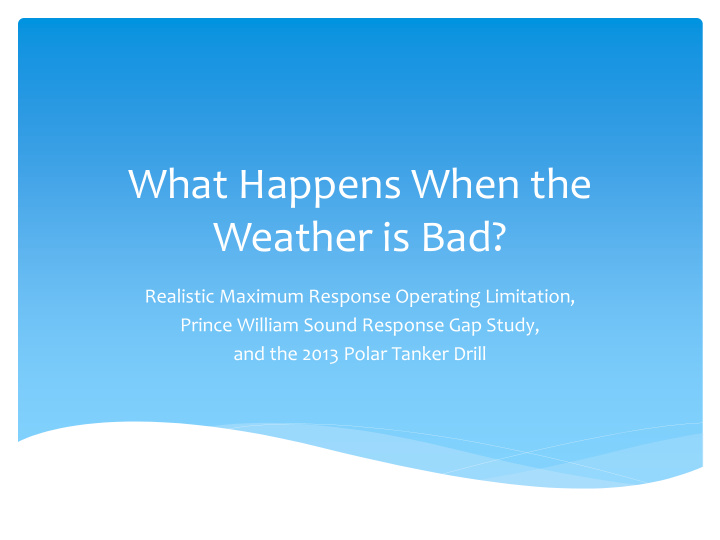



What Happens When the Weather is Bad? Realistic Maximum Response Operating Limitation, Prince William Sound Response Gap Study, and the 2013 Polar Tanker Drill
Realistic Maximum Response Operating Limitations (RMROL) Alaska State Oil Spill Contingency Plan Requires RMROL Description RMROL Limits Must be Defined RMROL Environmental Conditions Include Weather (wind, visibility, precipitation, and temperature) Sea States ,Tides, and Currents Ice and Debris Presence Hours of Daylight Other Known Environmental Conditions
Valdez Marine Terminal’s RMROL Summary Wind Speed Wave Height Annual Estimated Estimated Effect on Response (MPH) (Feet) Frequency Tactics 4 - 7 0.3 - 1.6 Mechanical – None 91% In-Situ Burning – None 13 - 18 1. 6 - 4.1 Dispersants – Mixing action may be limited 19 - 24 4.1 – 8.2 Mechanical – Skimming and 5.6% booming become progressively 25 - 31 4.1 – 13.2 more difficult 32 - 38 13.2 – 19.8 2.8% In-Situ Burning – Relative efficiency reduced by encounter rate 39 - 46 13.2 - 19.8 0.6% Dispersant – Natural dispersion is high, can be augmented
Prince William Sound Tanker C-Plan RMROL Summary for Wind and Sea Response Conditions That Could Adversely Impact A Response and Frequency of Method Occurrence and Duration Mechanical • Winds >30 to 40 kts - Frequency of wind 30 kts annually about 2% • Winds >40 kts – Frequency of wind 1% in winter • Seas > 3 meters (10 feet) – Frequency 5% annually and 15% Winter • Currents of one knot are exceeded approximately 25% of the time Dispersants • Winds >27 kts across the track of dispersant aircraft would likely preclude airborne application of dispersants • Frequency of 30 kts annually about 2% • In-Situ Winds >20 kts make it difficult to ignite oil or maintain the burn • Burning Frequency winds 20 kts annually 25%, Winter 30% • In-Situ Burning is limited by sea state same as mechanical response
Prince William Sound Response Gap Reports Environmental Response Mechanical Dispersants In-situ Burning Factor Limit Wind (Knots) Green < 21 > 10 to < 22 < 15 Yellow 21 to < 30 > 6 to < 10 or > 15 to < 20 > 22 to < 28 Red > 30 > 28 or > 20 > 0 to < 6 Sea State (Feet) Green < 3* otherwise < 4 > 2 to < 10 < 3 Yellow > 3* otherwise > 1 to < 2 > 3 to < 6 > 4 to < 8 Red > 6* otherwise > 8 > 10 or 0 to < 1 > 6 * When wave steepness parameter is > 0.0025
Prevention or Response Measures Implemented as Conditions Warrant Prevention Weather restrictions in specific areas (Hinchinbrook Entrance) Reduced transit speeds during periods of low visibility VTS special routing measures Ice reports from vessels transiting the area where ice conditions exist
Prevention or Response Measures Implemented as Conditions Warrant Response Responding vessels to spill site travel in groups Shoreline protection in sheltered areas will continue Open water boom deployment will occur in sheltered areas. Boom streams aft of F/V while traveling to spill Skimming and containment activities will make use of lees and reduced fetch by operating behind islands
Prevention or Response Measures Implemented as Conditions Warrant Response Because conditions vary considerably over PWS, the impact of weather will also vary. The response organization will maximize oil recovery for the conditions by focusing resources where they can work effectively. Skimming vessels will work down wind/current to minimize entrainment. Dispersant applications limited to directly down or up wind.
Polar Tanker PWS Drill October 2013 Spill scenario of a tanker collision with two barges off Montague Point. Total spill size over 500,000 bbls. The drill ran 48 hours continuously and included transition of command posts. Field response included 2 open water task forces and 2 sensitive area protection task forces.
Polar Tanker PWS Drill October 2013 Weather Summary • Weather reports from two NOAA sites and on scene reporting. • During hour 15 of drill the winds accelerated above 30 knots for approximately 9 hours. RMROL for open water recovery. • After hour 23 the winds came down below 30 knots and remained below for the duration of the drill.
Polar Tanker PWS Drill October 2013 Response Summary • Two open water barges mobilized to scene but did not deploy equipment. Nearshore barge mobilized and did not deploy equipment. • Fishing vessels mobilized and staged in Rocky Bay, Stockdale Harbor, Windy Bay, and Sawmill Bay for duration of exercise.
Polar Tanker PWS Drill October 2013 Response Summary • No sensitive area protection booming deployed and limited simulated sensitive area protection booming was completed. • Limited simulated dispersants applied by tug, no aerial application occurred. • The ICS form 209 (response summary) indicated that no oil was recovered at end of the 48 hours.
Conclusions RMROL conditions are not really unusual for Prince William Sound and the Gulf of Alaska More work is needed to setup a sensitive area protection system that can get ahead of the spill and work in sheltered areas during adverse conditions More planning and training is needed to make sure fall back tactics can be implemented when the RMROL conditions exist at spill site.
1978 Alyeska Oil Spill Contingency Plan Spill Containment on Open Waters An oil slick on open water that has moved away from the spill source will be contained by the Containment Slick Team. The Reconnaissance Supervisor will direct the team to the slick area and coordinate the team’s movements to most effectively contain the slick. The boom should be deployed to control the movement of as much of the oil slick as possible. Additional boom or additional teams may be required.
Recommend
More recommend